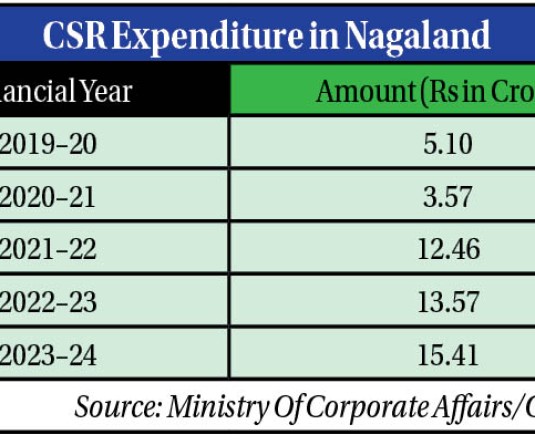Products made by the learners during the training sessions. (Morung Photo)
 (2).jpg)
AtonoTsükrü Kense
Kohima | March 30
In the remote corners of Nagaland, the villages of Laruri and Sütsü hold a secret of a quiet symphony of hands and earth. Here, time seems to slow, and the ancient pottery thrives not in bustling workshops but in the gentle hands of women who carry generations of knowledge within them.
Located about 115 km from Meluri Town in Nagaland’s newly formed district, a group of resilient women from these villages is keeping an ancient tradition crafts of pottery alive.
Amidst the changing world around them, the women continue to mould and shape clay by hand, just as their ancestors did for generations.
-(4).webp)
For Mowtsaa, who isn’t sure about her age, pottery isn’t just a craft - it’s a legacy passed down from mother to daughter. “Our village is a pottery village,” she proudly says, reminiscing about the days when every household relied on earthen pots for cooking and storage. “I learned this skill from my mother, just as every girl in our village did” she said.
As explained by the women, the process of making these traditional pots is long and meticulous. Without the aid of modern machines, the women collect specific types of clay, dry it for a week, pound it in wooden mortars, sieve, knead and re-pound it until it reaches the right consistency. The pottery is then shaped entirely by hand and left to dry indoors for a month before undergoing a traditional firing process using carefully selected woods and weeds.
-(5).webp)
It was told that the winter months from October to March become a time of creation for these women. Although it’s a laborious process which require patience and dedication, the air fills with the singing of the women as they sing and pound transforming it from fragile clay to enduring vessels.
Mowtsaa, a guardian of tradition
Interacting with to the Morung Express during a visit to Laruri, Mowtsaa, a guardian of tradition recalled how this tradition was passed down to her by her mother.
-(3).webp)
‘Our village is a pottery village’ said Mowtsaa as she recounts her childhood, a time when clay was life. “My mother taught me, just as her mother taught her. We girls, we will learned” she said.
In the olden days, she said, five to six different specific types of claywere used. Each clay has its own story and own place in their landscape. These clays once dried under the sun are pounded, sieved, kneaded and re-pounded before moulding it into the desired shapes and sizes.
She also recalled how those days; the earthen pots from their villages were in high demand enabling a family to comfortably sustain their families. “Those days everyone used earthen pots to cook and it was in high demand” said Mowtsaa.
However, as modern utensils replace clay pots, the demand for traditional pottery has dwindled, making it difficult for artisans to sustain themselves through this craft today, said Mowtsaa.
And even as some of them continue to make clay pots, she pointed out that due to the distance, road condition and the fragility of the pots, it is not feasible to transport outside for sale.
A unique tradition
Describing in brief the detailed process of making a clay pot, Thhüsesü, President Pochury Mothers’ Association said three different types of clay are used namely chokhong (black clay), küsükhong (white clay) and lüratvü (orange) is used which are collected from particular places.
-(1).webp)
They clay are then dried for a week in the sun followed by pounding of black and white clay in traditional wooden mortar and pestle, which is then sieve, knead with water in small portion till it is soft, and re-pound it again till it becomes very soft and sticky.
Thhüsesü emphasised that they don’t use any machineries or equipments and that everything is done with hands manually from pounding to shaping. In an average, she said 2-3 pots can be made in a day, while big ones take 2-3 days to complete and the finished products will kept inside the room for a month to slowly dry.
Once it is dry, the finished product goes through another process of burning with specific woods (sumac) and weeds (hyparrheniarufa). While small pots are burnt from the outside, the big ones, she explained is burnt both inside and outside while smearing it with the orange clay for the finishing.
-(2).webp)
A call to preserve heritage
This tradition, like the delicate clay pots themselves faces the threat of fragility as modernisation with its allure of convenience is luring many away from the old ways.
However, the women of Laruri and Sütsü are not just passive guardians of a fading art, they are active custodians determined to pass on their heritage.
Expressing concern on the gradual dwindling tradition of age-old craft of pottery, Thhüsesü said, they organise training sessions, nurturing the next generations of pottery, particularly the girls and young mothers and instilling in them the importance of their roots.
“We are losing many of our good old traditions due to modernisation” Mowtsaa laments and with a quiet sense of urgency said “we have to stay connected to our roots and tradition and my desire is that our younger generation must learn this craft.”
The storage of paddy and seeds in large earthen pots is another beautiful tradition of these villages. As Thhüsesü explained, the grains significantly last longer in these pots than those kept in traditional bamboo basket.
Most of the large storage pots are very old, which it was learnt dates back to generation passed down from generation to generation.
The ingenuity of these villagers also include the construction of their storage barns away from the residence with a dedicated place to dry their paddy, which is also convenient as the chicken doesn’t come to peck on the grains. Explaining the integration of tradition and practicality, Thhüsesü said they can just dry their paddy and go about their work and come back to retrieve it in the evening.






